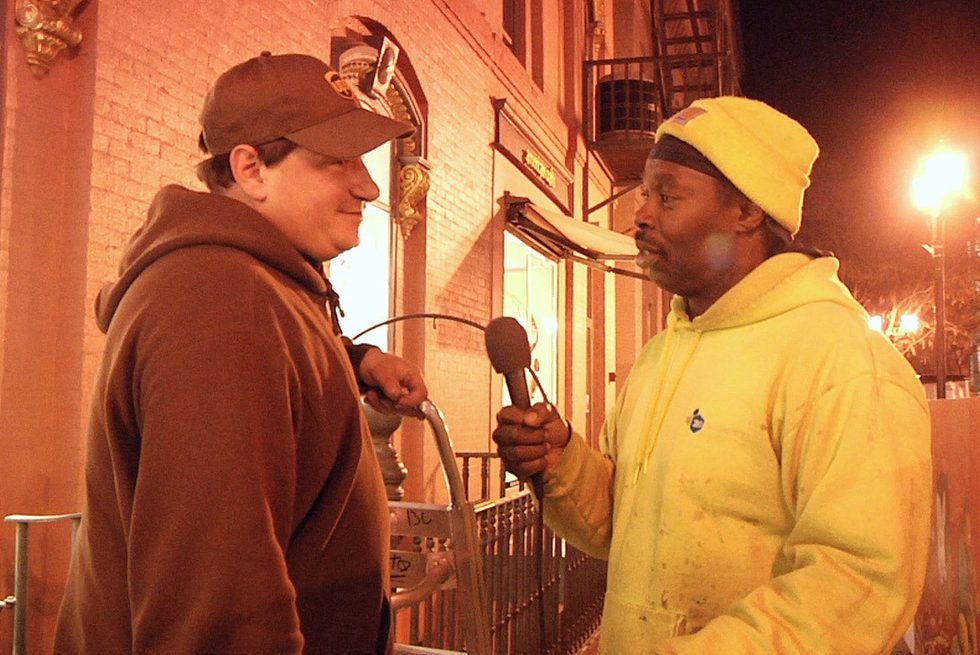Documenting Worker Struggle
From the Series: Ethnocine: Get By
From the Series: Ethnocine: Get By

How do we get by? In the midst of a rising Movement for Black Lives and global pandemic, Emily Hong's Get By (2014) visualizes the possibilities and limits of solidarity across race and class in a Black-led living wage campaign in Ithaca, New York. The chorus of voices that open and close the film highlight the collective dimensions of social justice struggle. In the opening sequence, Hong decenters the individual as she carefully crafts an audiovisual argument about the multivocality of worker–community solidarity. After a black screen cues us to listen closely to a robust series of worker-led call-and-response chants, the film cuts to a public demonstration for a living wage for essential workers. The camera eye slowly rotates around, and from within, a circle of protestors. Featuring multiple voices, the film challenges conventions of authorship and character-driven films in the documentary industry, which locate the individual as the locus of authority and transformation. In taking a collaborative filmmaking approach, the film explores asymmetrical relations between workers and community members, and anthropologists and their interlocutors.
Milton and Stanley, two worker-organizers, want people who watch the film to realize that the living wage campaign is a collective effort. As Hong and Milton watch rushes together in an editing suite, Milton makes a suggestion that echoes his assertion, "We are not just fighting for us." He asks Hong to feature other people in the film and ask them about a living wage. Milton, sensing the hesitation in Hong's voice, models solidarity and immediately extends himself, "If you want, I'll do it." In including this exchange, Hong conveys the ways that interlocutors challenge and support anthropologists, often through leading by example. The film then cuts to a short series of impromptu conversations between Milton, Stanley, and other workers and community members. Hong's choice to include long takes of a few of these conversations conveys the emotional and physical labor necessary for organizing and movement building with a range of workers.
The class stratification and racialization of worker–community solidarity in Ithaca is a key thread of the film. The juxtaposition of the whiteness of the legislators and wider community allies with the Blackness of the workers is stark. Milton tells Stanley that they "need to be more like this sometimes," as he gestures toward his worn neon yellow hoodie. Implicit in the statement and explicit in the film is the operative racialized hierarchy that guides lawmaking and standards of worker compensation. Referring to how he and Stanley wear suits in their interactions with white legislators and news media, Milton says that, "In order for people to understand where we are coming from, they [legislators] have to see that [our working-class clothes]." Here, Hong gestures toward the work of the anthropologist and filmmaker to document and engage different worlds, to challenge dominant visuals and narratives, especially when reconciliation sometimes feels uncertain.
New to Ithaca myself, working at a predominantly white, elite university and living in a predominantly white neighborhood dotted with Black Lives Matter yard signs, the film has heightened my awareness of the race and class divides in central New York. In visually documenting a Black-led living wage campaign through innovative production methods, Get By exposes the injustice of the simultaneous valorization and dispensability of the low-wage "sacrificial worker" in the United States and more broadly (Gidla 2020). The film, especially in light of its reading in the current moment of Covid-19, reminds us of the uneasy fact that even getting by is a luxury many can't afford.
Gidla, Sujatha. 2020. "'We Are Not Essential. We Are Sacrificial.'" New York Times, May 5.